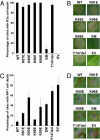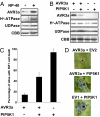Phosphatidylinositol monophosphate-binding interface in the oomycete RXLR effector AVR3a is required for its stability in host cells to modulate plant immunity
- PMID: 21821794
- PMCID: PMC3167543
- DOI: 10.1073/pnas.1106002108
Phosphatidylinositol monophosphate-binding interface in the oomycete RXLR effector AVR3a is required for its stability in host cells to modulate plant immunity
Abstract
The oomycete pathogen Phytophthora infestans causes potato late blight, one of the most economically damaging plant diseases worldwide. P. infestans produces AVR3a, an essential modular virulence effector with an N-terminal RXLR domain that is required for host-cell entry. In host cells, AVR3a stabilizes and inhibits the function of the E3 ubiquitin ligase CMPG1, a key factor in host immune responses including cell death triggered by the pathogen-derived elicitor protein INF1 elicitin. To elucidate the molecular basis of AVR3a effector function, we determined the structure of Phytophthora capsici AVR3a4, a close homolog of P. infestans AVR3a. Our structural and functional analyses reveal that the effector domain of AVR3a contains a conserved, positively charged patch and that this region, rather than the RXLR domain, is required for binding to phosphatidylinositol monophosphates (PIPs) in vitro. Mutations affecting PIP binding do not abolish AVR3a recognition by the resistance protein R3a but reduce its ability to suppress INF1-triggered cell death in planta. Similarly, stabilization of CMPG1 in planta is diminished by these mutations. The steady-state levels of non-PIP-binding mutant proteins in planta are reduced greatly, although these proteins are stable in vitro. Furthermore, overexpression of a phosphatidylinositol phosphate 5-kinase results in reduction of AVR3a levels in planta. Our results suggest that the PIP-binding ability of the AVR3a effector domain is essential for its accumulation inside host cells to suppress CMPG1-dependent immunity.
Conflict of interest statement
The authors declare no conflict of interest.
Figures






Comment in
-
Showdown at the RXLR motif: Serious differences of opinion in how effector proteins from filamentous eukaryotic pathogens enter plant cells.Proc Natl Acad Sci U S A. 2011 Aug 30;108(35):14381-2. doi: 10.1073/pnas.1111668108. Epub 2011 Aug 19. Proc Natl Acad Sci U S A. 2011. PMID: 21856948 Free PMC article. No abstract available.
Similar articles
-
Phytophthora infestans effector AVR3a is essential for virulence and manipulates plant immunity by stabilizing host E3 ligase CMPG1.Proc Natl Acad Sci U S A. 2010 May 25;107(21):9909-14. doi: 10.1073/pnas.0914408107. Epub 2010 May 10. Proc Natl Acad Sci U S A. 2010. PMID: 20457921 Free PMC article.
-
The RXLR motif of oomycete effectors is not a sufficient element for binding to phosphatidylinositol monophosphates.Plant Signal Behav. 2013 Apr;8(4):e23865. doi: 10.4161/psb.23865. Epub 2013 Feb 20. Plant Signal Behav. 2013. PMID: 23425855 Free PMC article.
-
Phytophthora infestans RXLR-WY Effector AVR3a Associates with Dynamin-Related Protein 2 Required for Endocytosis of the Plant Pattern Recognition Receptor FLS2.PLoS One. 2015 Sep 8;10(9):e0137071. doi: 10.1371/journal.pone.0137071. eCollection 2015. PLoS One. 2015. PMID: 26348328 Free PMC article.
-
Towards understanding the virulence functions of RXLR effectors of the oomycete plant pathogen Phytophthora infestans.J Exp Bot. 2009;60(4):1133-40. doi: 10.1093/jxb/ern353. Epub 2009 Feb 9. J Exp Bot. 2009. PMID: 19204033 Review.
-
Eukaryotic virulence determinants utilize phosphoinositides at the ER and host cell surface.Trends Microbiol. 2013 Mar;21(3):145-56. doi: 10.1016/j.tim.2012.12.004. Epub 2013 Jan 30. Trends Microbiol. 2013. PMID: 23375057 Free PMC article. Review.
Cited by
-
Genetic variation along an altitudinal gradient in the Phytophthora infestans effector gene Pi02860.Front Microbiol. 2022 Sep 8;13:972928. doi: 10.3389/fmicb.2022.972928. eCollection 2022. Front Microbiol. 2022. PMID: 36160230 Free PMC article.
-
At the Frontier; RXLR Effectors Crossing the Phytophthora-Host Interface.Front Plant Sci. 2011 Nov 1;2:75. doi: 10.3389/fpls.2011.00075. eCollection 2011. Front Plant Sci. 2011. PMID: 22645549 Free PMC article.
-
Fast and Inexpensive Phenotyping and Genotyping Methods for Evaluation of Barley Mutant Population.Plants (Basel). 2020 Sep 6;9(9):1153. doi: 10.3390/plants9091153. Plants (Basel). 2020. PMID: 32899989 Free PMC article.
-
Relocalization of late blight resistance protein R3a to endosomal compartments is associated with effector recognition and required for the immune response.Plant Cell. 2012 Dec;24(12):5142-58. doi: 10.1105/tpc.112.104992. Epub 2012 Dec 14. Plant Cell. 2012. PMID: 23243124 Free PMC article.
-
Ubiquitination during plant immune signaling.Plant Physiol. 2012 Sep;160(1):15-27. doi: 10.1104/pp.112.199281. Epub 2012 Jun 11. Plant Physiol. 2012. PMID: 22689893 Free PMC article. Review. No abstract available.
References
-
- Haverkort AJ, et al. Societal costs of late blight in potato and prospects of durable resistance through cisgenic modification. Potato Res. 2008;51:47–57.
-
- Haas BJ, et al. Genome sequence and analysis of the Irish potato famine pathogen Phytophthora infestans. Nature. 2009;461:393–398. - PubMed
-
- Kamoun S. A catalogue of the effector secretome of plant pathogenic oomycetes. Annu Rev Phytopathol. 2006;44:41–60. - PubMed
-
- Oliva R, et al. Recent developments in effector biology of filamentous plant pathogens. Cell Microbiol. 2010;12:705–715. - PubMed
-
- Birch PRJ, et al. Oomycete RXLR effectors: Delivery, functional redundancy and durable disease resistance. Curr Opin Plant Biol. 2008;11:373–379. - PubMed
Publication types
MeSH terms
Substances
Associated data
- Actions
LinkOut - more resources
Full Text Sources
Other Literature Sources

